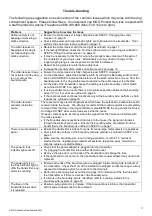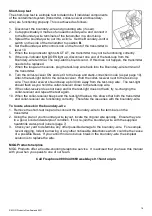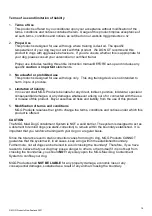
18
© MGG Products New Zealand 2021
Short-loop test
The short-loop test is a simple test to determine if individual components
of the containment system (transmitter, collar-receiver and boundary-
wire) are functioning properly. This is achieved as follows:
1. Disconnect the boundary-wire and grounding wire (if used).
2. Cut approximately 4 metres of unused boundary-wire and connect it
to the Boundary-wire terminals of the transmitter in a short-loop.
3. Spread the boundary-wire out into a circle. Set the Boundary-control
switch on the side of the transmitter to position
B
.
4. Set the Boundary-width control knob on the front of the transmitter to
level 10.
5. When the loop-indicator light is NOT LIT, the transmitter may not be functioning correctly.
6. If the loop-indicator light DOES light up, disconnect one end of the test-loop from the
Boundary-wire terminal. The loop-alarm should sound. If this does not happen, the transmitter
needs to be replaced.
7. When the loop-alarm sounds, plug the test-loop wire back into the Boundary-wire terminal of
the transmitter.
8. Turn the collar-receiver ON and set it to the beep and static-correction mode (as per page 10).
Attach the test-light bulb to the collar-receiver. Hold the collar-receiver next to the test-loop
wire. The collar-receiver should beep up to 30cm away from the test-loop wire. The test-light
should flash as you hold the collar-receiver closer to the test-loop wire.
9. If the collar-receiver does not beep and/or the test-light does not flash, try re-charging the
collar-receiver and repeat the test again.
10. When the collar-receiver beeps and the test-light flashes, this shows that both the transmitter
and collar-receiver are functioning correctly. Therefore the issue lies with the boundary-wire.
To locate a break in the boundary-wire
1. Remove the short-test loop and reconnect the boundary-wire to the terminals on the
transmitter.
2. Using the plan of your boundary-wire layout, locate the original wire splicing. Ensure they are
in a good, solid and waterproof condition. If not, re-join the boundary-wire with the supplied
heatshrink water-proof joiners (page 7)
3. Check your yard to determine any other possible damage to the boundary-wire. For example,
recent digging, rodent burrowing or any other noticeable disturbance which could be the cause
of a possible break. If you cannot find an obvious break in the boundary-wire the simplest
solution is to replace the wire.
MGG Products helpline
MGG Products offer a trouble-shooting telephone service. It is advised that you have this manual
with you when you speak to one of our team.
Call Freephone 0800 449 669 weekdays 9.15am to 4pm



































